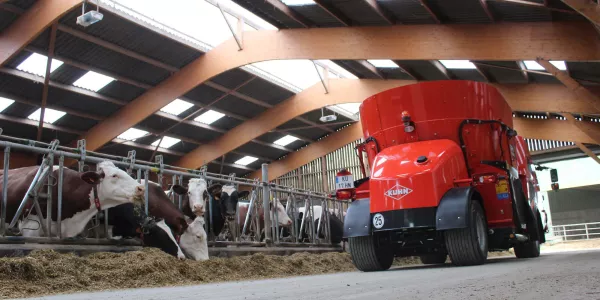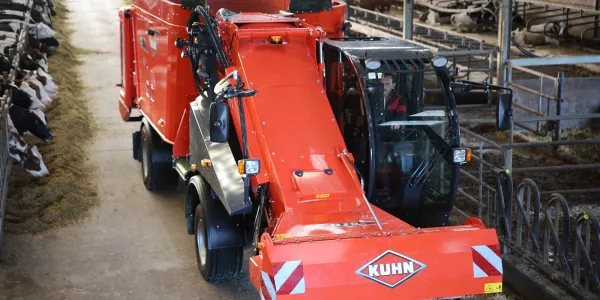Reducing the carbon footprint
More and more farmers have committed to reducing their carbon footprint (Dairy Carbon, etc.) by limiting their use of petroleum products. The self-propelled mixer wagon is part of this approach because it reduces total fuel consumption. There is only one engine for feeding the whole herd.
Self-propelled mixer wagon vs mixer wagon
Comparison between a self-propelled mixer solution and a trailed mixer in a cattle farm with 120 dairy cows.
Solution 1: A trailed concrete mixer with tractor and telescopic loader.
The trailed mixer requires a tractor and handling equipment to load the machine. Example of the use of an 18 m3 mixer with a vertical twin screw, amortized over 7 years. The farmer mixes 3 times a day, operating 444 hours a year.
Solution 2: Self-propelled vertical screw mixer.
The self-propelled mixer does not require any other machine for its daily operation. Example of the use of an SPV POWER 15.1 DL self-propelled mixer with a vertical screw.
In the situation described above (120 dairy cows), the self-propelled mixer has a 24% lower operating cost.
Operating costs
The more blends your self-propelled mixer makes, the more valuable it is in terms of operating costs. This is because you save daily uptime, which is a factor in calculating daily costs. As the number of mixtures increases, the difference in the time required to prepare rations increases.
Simplified maintenance
Only one engine is powered to perform all daily feeding tasks compared to two with a conventional system (trailed mixer + tractor + telescopic loader). From a maintenance point of view, all the necessary maintenance operations are carried out on a single machine.
Fewer daily operations with a self-propelled mixer wagon
When comparing the daily operations of the "trailed mixer + tractor + telescopic loader" solution with the "self-propelled feed mixer" solution, there is a daily time saving of 8 to 10 minutes for each mixed portion.
Self-propelled mixer equipment
The self-propelled mixer is equipped to get the most out of precision weighing.
Weighing unit in the cab
With a weighing unit in the cab, you can check the amount of ingredients in the ration at a glance during the loading phase. You can stop the loading of ingredients precisely when the programmed amount is reached. In comparison, a loading bucket for trailed mixers would be less accurate.
Your ration is constant, and you will reduce leftovers at the trough.
Efficient distribution











